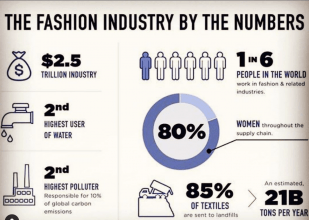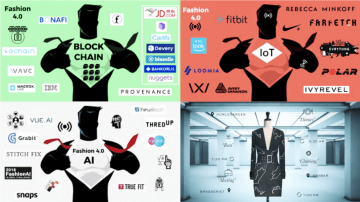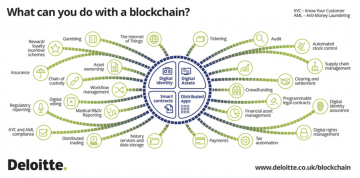
Fastech AI Blockchain and the $3 Trillion Fashion Industry Part 1
With Hernaldo Turrillo
AI and Blockchain are the foundational trust technologies of our time. Blockchain or distributed ledger technologies have a holistic DNA and multiple capacities that can fix issues such as supply chain track record to create trust in provenance of products, identify sources of production and manufacturing and also fix some middle men serious issues. AI on the other hand can improve from all areas of understanding data to optimisation of processes in the global business landscapes. These are optimisation of resources, preview issues and finding the best approach to tackle issues, automate and predict and manage in real time high concerns of production, distribution and quantify and optimise processes and operations.
The challenges however with these advanced and new technologies is that it requires lots of maturity and a strong road map how to push them forward in an ethical beneficial way, plus how to make it a global powerhouse driven by the right values ( not only maximisation of profit) that work to improve real things, besides the hype and find real scope and scalable solutions to entire industries and sectors. When it comes to AI and blockchain, can these techs and the new fashtech movement contribute to an optimisation of the fashion industry?
The $3 trillion fashion industry, which is 4% of the world’s Gross Domestic Product (GDP) is a complex ecosystem, on the verge of collapse. Be no fool, you are part of it! As a consumer, designers, fashion industry player and producer plus the end of the chain shopper, we are all deeply embedded in this attractive industry, which has lots of issues and concerns. and is on high alert on the agenda. Moreover its $800 billion global apparel industry, has become notoriously famous for its challenges when it comes to:
- Ethical treatment of industry workers;
- IP, counterfeit supply chain issues;
- Environmental damage and sustainability
- Unlawful competition, and lack of rentability of the industry.
1 in 6 people in the world is somehoinvolved in the fashion industry. How then, can AI and DLT blockchain technologies help solving some of these issues and challenges?

Its issues, now going into detail, have to do with ill handling of workers, slurping up waters, as a report by the Boston Consulting Group attested, counterfeit, handling of production by emerging countries with different standards in terms of waste disposal and treatment of workers and many more. Adding to all this every year, the fashion manufacturing produces over 92 million tons of solid waste, most of which goes to horrible and inhuman landfills or up in smoke, or it is sold to countries such as Malaysia.
Last year one of the major fashion premium global brands alone was called out for burning $37 million of clothes and goods rather than selling them at a discount — a common practice to maintain a brand’s luxury shine.
Much has been written about blockchain in these few tech-frenzy years and much has been talked about how unfair and unsustainable is the fashion industry in today’s monopolized world. If blockchain is capable of setting up a decentralized and more democratic platform, can fashion be disrupted (for good) by this technology? Quick answer: yes, blockchain (theoretically) can help towards a more inclusive, sustainable fashion industry within the Fashtech movement. However, we are still in the beginning of it, and the road ahead is long and complex, and in deep need to walk the talk and truly look into the detail of what blockchain really is.
The fashion industry, as many other industries worldwide like Finance and its technological branch Fintech, is going through deep changes. Customers are becoming more consicous, and starting to pay attention to where the products come from, the conditions of the workers and, utterly, the impact on the environment that the clothes have. Meanwhile, new designers in the skin of entrepreneurs and new collaborations are trying to make things differently to their well-known big rivals. They have found a loophole in this overpopulated market to really make a difference while being able to provide affordable, sustainable and a fairer products. In this article, we will then, look at how the 4IR technologies of AI and blockchain, can be used to support the urgent change so badly needed in the fashion industry.
1.Fastech – Fashion Technology And The 4IR – AI and Blockchain

Fastech is a word used increasingly in the fashion industry. What it means is quite simple: putting technology at the service of the fashion industry. An accurate definition is the one provided by fashion expert Alfonso Segura: “We are living an incredible disruption in Fashion Retail, an industry that innovated the way to manage supply chain to reduce seasonality risks (uncertainty of demand, overstocks, low-cost manufacturing versus lead times, postponement). Nowadays, Fashion retail, again, is the example for other industries that need to transform their businesses in the digital era. Online is impacting the way traditional businesses understand retail expansion and market approach. Many fashion retailers are reducing their expansion plans based on brick-and-mortar, while others are closing stores and even closing their business. Zara, Amazon and other behemoths are taking part of this revolution, but long tailers, niche pure players, are the ones fueling it. And again, it’s the most adaptable that will survive, not the strongest.”
Digitization is going to happen sooner than later in the fashion industry and those who are quicker to embrace also the new technologies – Artificial Intelligence, Augmented Reality, Virtual Reality or 3D Printing – will be the ones with more odds on their side to expand. However, these fancy techs in themselves, don’t assure the needed change to improve an unfair, unsustainable and opaque industry per se. They have to be bolstered by a strong will, and an entrepreneurship mindful of the balance between seeking profit and the social and environment impact of the products it advertises. Only then, can the technology really help to make the promised changes.
And that’s the point where blockchain enters the game. This distributed ledger technology can efficiently manage large amounts of data, in real time, in a ( theoretically) decentralized platform, while its encryption model can keep undesired eyes off the network. A blockchain-based platform can improve basically any business, operation, transaction or endeavour, and it does so from the very foundational point. Being decentralized means that all computers connected to the blockchain-based network need to agree that a modification in the network is genuine, so middlemen and intermediaries aren’t needed anymore.
2. Blockchain ID, Trust Supply Chain to Counterfeit
“Blockchain also eliminates inefficiencies in international trade allowing all members of the supply chain (carriers, banks, traders, suppliers, etc.) to connect to a secure decentralized network, exchanging information, documents and data, directly. Blockchain reduces payment risks and prevents fraud while facilitating fast, secure, low-cost international payment processing services,” said the aforementioned expert Alfonso Segura about how blockchain could help the fashion industry.
Blockchain also supports smart contracts in an industry where email order confirmation is almost a rule. This will reduce human errors and misunderstandings regarding payment terms, returns, purchases, etc.
But promising to change the world as it stands isn’t enough. The world needs to see the blockchain in action. Some people out there, fighting for a better fashion industry have looked for new technologies, specially blockchain, as one of their strongest allies. Utterly, blockchain is something to be hopeful for so long it lands in the right hands. It has been linked to powerful words such as “revolution“, “manifesto”, “ecosystem”, “collaboration”, “transparency“ or “decentralization”.

A possible example of how blockchain is applied today in the Fastech industry can be found in Martine Jarlgaard, a british fashion house that announced a partnership with Provenance, in 2017, a blockchain technology-based startup. Blockchain allows brands to tell more of a story and give credit to all the people involved in the process. Every product has a story, from raw materials to the store, each part of the value chain is identified, as CEO Martine said.
There are also many other examples of how blockchain is influencing the fashion industry. “Nowadays, one of the majors trends are sustainability and circular economy. Customers want to know where the product is coming from, and not only in Grocery but also in Fashion. Patagonia and Everlane are two good examples of companies betting on traceability and sustainability in their supply chains, allowing customers to identify their suppliers,” added the aforementioned thought learder Alfonso Segura.
In fact, many examples can be found in the rapidly growing Fashtech industry.
Blockchain and peer-to-peer are highly linked and that’s the foundation motif from where Coin Fashion built its “ecosystem” based on peer-to-peer principles. For them, the final customer should be connected to a designer directly on a basis of trust and the final customer should play a key role in the process of creation (co-creation, customization); p2p promotion; co-pricing (paying less for being involved more); and in something quite innovatibe – co-investing.
BONAFI is a blockchain company founded in LA which is on a mission to defend all brands and retailers big and small, and protect consumers from counterfeits by implementing a fail-safe authentication system using blockchain technology.
Implemented at a large scale, it can drastically change supply chains over the world, the way electricity is consumed, delivered and paid off. It has even disrupted, for better or worse, the financial industry over the world with the cryptocurrencies and all the products that came after them: ICOs for funding, tokenization, etc. The blockchain technology with the advent of Internet. We are talking about a foundational technology of the Fourth Industrial Revolution: that is the potential of the technology we have in hands right now. And now, it is at the entire service of the Fashtech industry.
Finally, we can also find other examples using AI and blockchain. JD.COM, one of China’s largest e-commerce companies, has launched a new artificial intelligence machine called an AI Catapult accelerator that will focus on the development of AI and blockchain technologies. its first batch includes six companies: Bankorus, CanYa, Bluezelle, Nuggets, Republic Protocol and Devery.
This is the part one of a 2 Parts article research

Dinis Guarda is an author, academic, influencer, serial entrepreneur, and leader in 4IR, AI, Fintech, digital transformation, and Blockchain. Dinis has created various companies such as Ztudium tech platform; founder of global digital platform directory openbusinesscouncil.org; digital transformation platform to empower, guide and index cities citiesabc.com and fashion technology platform fashionabc.org. He is also the publisher of intelligenthq.com, hedgethink.com and tradersdna.com. He has been working with the likes of UN / UNITAR, UNESCO, European Space Agency, Davos WEF, Philips, Saxo Bank, Mastercard, Barclays, and governments all over the world.
With over two decades of experience in international business, C-level positions, and digital transformation, Dinis has worked with new tech, cryptocurrencies, driven ICOs, regulation, compliance, and legal international processes, and has created a bank, and been involved in the inception of some of the top 100 digital currencies.
He creates and helps build ventures focused on global growth, 360 digital strategies, sustainable innovation, Blockchain, Fintech, AI and new emerging business models such as ICOs / tokenomics.
Dinis is the founder/CEO of ztudium that manages blocksdna / lifesdna. These products and platforms offer multiple AI P2P, fintech, blockchain, search engine and PaaS solutions in consumer wellness healthcare and life style with a global team of experts and universities.
He is the founder of coinsdna a new swiss regulated, Swiss based, institutional grade token and cryptocurrencies blockchain exchange. He is founder of DragonBloc a blockchain, AI, Fintech fund and co-founder of Freedomee project.
Dinis is the author of various books. He has published different books such “4IR AI Blockchain Fintech IoT Reinventing a Nation”, “How Businesses and Governments can Prosper with Fintech, Blockchain and AI?”, also the bigger case study and book (400 pages) “Blockchain, AI and Crypto Economics – The Next Tsunami?” last the “Tokenomics and ICOs – How to be good at the new digital world of finance / Crypto” was launched in 2018.
Some of the companies Dinis created or has been involved have reached over 1 USD billions in valuation. Dinis has advised and was responsible for some top financial organisations, 100 cryptocurrencies worldwide and Fortune 500 companies.
Dinis is involved as a strategist, board member and advisor with the payments, lifestyle, blockchain reward community app Glance technologies, for whom he built the blockchain messaging / payment / loyalty software Blockimpact, the seminal Hyperloop Transportations project, Kora, and blockchain cybersecurity Privus.
He is listed in various global fintech, blockchain, AI, social media industry top lists as an influencer in position top 10/20 within 100 rankings: such as Top People In Blockchain | Cointelegraph https://top.cointelegraph.com/ and https://cryptoweekly.co/100/ .
Between 2014 and 2015 he was involved in creating a fabbanking.com a digital bank between Asia and Africa as Chief Commercial Officer and Marketing Officer responsible for all legal, tech and business development. Between 2009 and 2010 he was the founder of one of the world first fintech, social trading platforms tradingfloor.com for Saxo Bank.
He is a shareholder of the fintech social money transfer app Moneymailme and math edutech gamification children’s app Gozoa.
He has been a lecturer at Copenhagen Business School, Groupe INSEEC/Monaco University and other leading world universities.





























